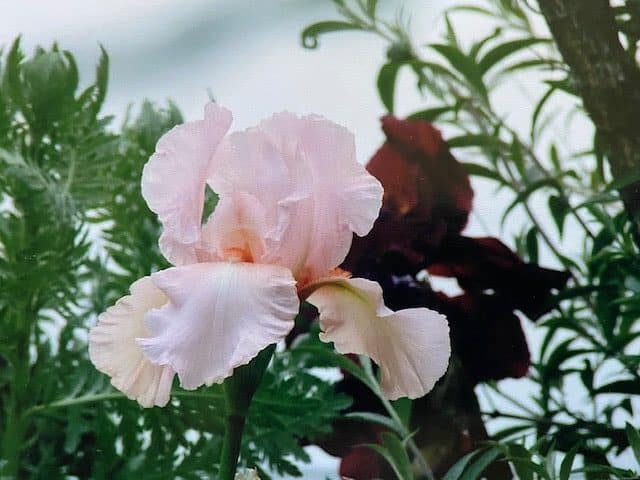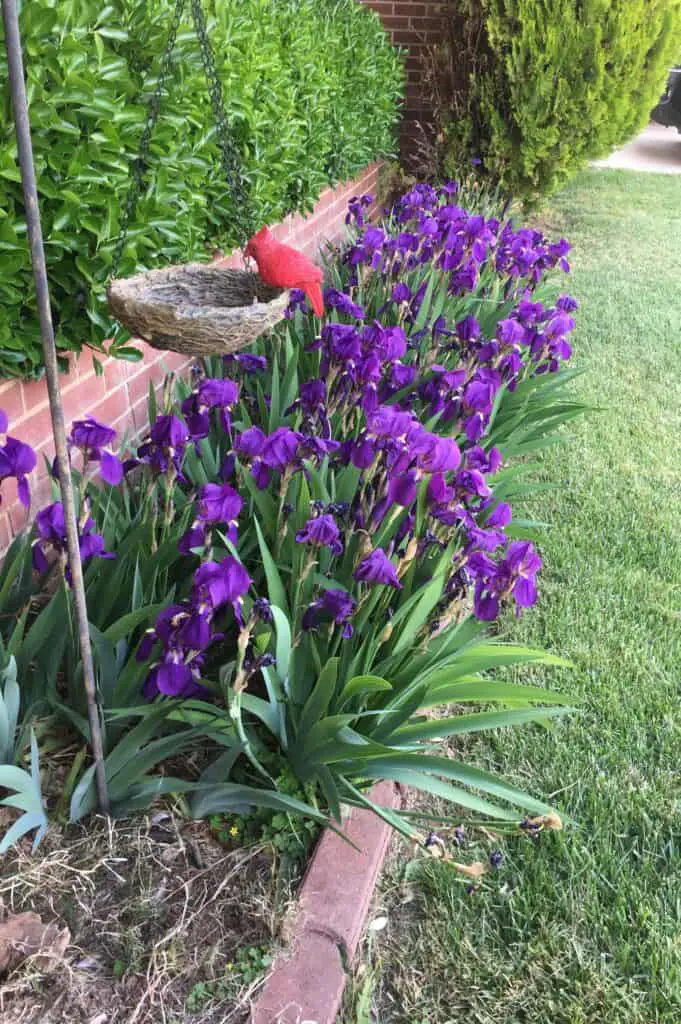Spring is trying to burst forth with all the glory it can possibly muster. It’s having a bit of a hard time. Never fear, the “flags” are here. One of the first beautiful flowers to welcome the rebirth of this world is the IRIS (I grew up calling this flower a flag).
In this article we will show you the different kinds of Iris and how to grow them. They have been nicknamed the Poor Man’t Orchid.
Greeting the season from mid April thru June in a variety of colors from pale yellows, soft pinks, bright lavenders and even blacks and white, these blooms bring joy in a bouquet in the house, in a row along the edge of a garden or in a field just full of plants. The name Iriscomes from the Greeks and it means “Goddess of the Rainbow”. Not a bad gig to have.
There are over 200 different species, but we will discuss five of the more popular. The Bearded Iris, also called the German Iris is perhaps the best known. It is bigger and taller than the other species. But there are also Dutch Iris, Siberian Iris, Japanese and Louisiana Iris. This flower is a world traveler.
It has been said that you can abuse this plant, leave it in the road and run over it, forget to water it and then feel remorse and plant it in dirt and it will repay you with beautiful flowers, even blooms that have a most intoxicating fragrance. But let’s not try to prove this theory. Instead let’s do it RIGHT. We will start at the very beginning.

GROWING BEARDED IRISES
The root section of the plant is called a rhizome. This can have tendrils off of it that look like roots. When you get a start for an iris it will generally be a chunk of the rhizome with a knob or two on it and a tendril of two also.
You should have an area to place this plant that will have at least 6 hours of direct sun. The soil should be loose and should drain well. You can work a bit of compost in the planting area before putting the rhizome in. The rhizome looks like a sausage half buried in the soil.
The plant does NOT like to be buried. Part of the rhizome should be above ground, about ¼ to ½ inch above the soil line. Iris like to have their backs to the sun. Cover the rest of the plant with soil.

Arrange the tendrils or roots down in the soil before covering with dirt. Water the iris in, but don’t drown it. Iris do NOT like soggy feet. When the top dries, water again.
The Bearded Iris develop large clumps of rhizomes and need to be divided every few years. One of the easiest ways to divide a clump is to take a sharp shovel and make a cut down the center of the plant leaving one half of the plant in the ground and prying the other half out. Bed the original back in with dirt and then divide the loose half into several pieces. Plant together in small groups or singly.
The new divisions will quickly take hold and start developing their fans of leaves and blooms. The Bearded Iris loves to grow horizontally as well as sending roots into the earth.
You can also dig up the entire plant, divide into smaller sections with a sharp knife and replant in your garden, with enough to share.
The Bearded Iris flower is made up of uprights and falls. The blooms on these plants are beautiful and some have the fragrance of an expensive perfume.
Some could take the place of an orchid in a corsage, but don’t do like a friend of mine that brought the flower, leaves, roots and dirt to give to his girlfriend for prom. (That romance didn’t last)

This was and is still one of the best garden flowers to put in a cut bouquet for decorating gravesites for memorial day. This is a tradition that we observe at the end of May and it is very satisfying to use blooms from the iris that our mother had cultivated all her gardening days.
The old iris plants have survived many divisions, many transplantings, but I will tell you that naming your plants and talking to them about how beautiful they are will reap rewards. A companion flower, the Oriental Poppy has some of the same growing habits of the iris and makes a great companion in the garden, along with a beautiful display of blooms.

GROWING BEARDLESS IRISES
Japanese Iris
This beautiful flower goes by many names, the Kaempferi Iris, the Butterfly Iris, but most commonly known now as the Japanese Iris. The come in luscious colors of purple, pink and endless bi-colors. Cultivated in Japan for over 500 years, they were strictly for the royal gardens.
These beauties like a moist environment similar to ferns, astilbes or impatiens. The petals of this beauty all flat, forming a simpler, flatter flower. They like to form large, lavish clumps and are very decorative. They are also prized as a cut flower in bouquets.

Siberian Iris
This Iris is favored by landscapers for many reasons. It is a very hardy plant. Once established it will live for generations . The flowers bloom on slender stems in colors of blue, yellow and purple (other colors are slowly being added). After the blooms have faded, the leaves remain and look as beautiful as any other garden grass. They can be planted in spring or fall
Louisiana Iris
These magnificent Irises are our own native plants’ spectacular wildflowers. They hail from the bayous and wetlands of the Gulf Coast. They have large flowers often from 4 to 6 inches across and a form more like the Japanese type’s flatter and wider than the tall up-and-down Bearded Iris bloom.
The hybrids of these beauties are often hardy all the way to Canada. They enjoy conditions similar to the Japanese types, so all you need is a moist area, rich soil, and partial shade. Any well-watered partially-shaded perennial garden will do. This group is world famous for its large flowers and wide palette of coloring, featuring some colors found in no other group.
Wild Iris
Many of the ‘species’ or wild irises are among the Spring-planted beardless group. The two best known are the ”Blue Flag’ (loved by the Northeast) and the taller “Yellow Flag” grown in England.
The Blue Flag is a perfect wild flower but the Yellow Flag has a tendency to spread and can clog up small waterways. In places it may be considered an invasive plant.
Water Iris
There is a misconception that iris from the beardless group tend to like water and would prefer to be planted in water. Nothing could be further from the truth. These beauties like to keep their complexions (and roots) moist, but not dripping.
They can enjoy being near a pond or stream, but do quite well in a well –watered perennial garden. One exception is the Siberians. They like moisture, but are perfectly happy with normal conditions and don’t resent drying out from time to time.

Mulching and Fertilizing Spring-planted Irises
Mulching is important for this group. Since they enjoy moist, partially-shaded conditions, mulch their roots to help them retain moisture during warm dry periods. Bark chips, peat, or any good moisture-retaining mulch will be a big help. Full sun is ok, too, but no irises should be in blazing hot dry areas.
They need no more than the usual feeding, like most flowering perennials. For feeding perennial gardens, expert Frederick McGoury recommends familiarizing yourself with standard perennial flower fertilizers, which are always labeled with three numbers in a sequence, such as 5-10-5 or 5-10-10. These numbers on the bag refer to percentages of Nitrogen, Phosphorus and Potassium.
MGourty explains that the most important element for flowering plants is the middle number, Phosphorus, so he recommends choosing a fertilizer with the middle number no lower than the other two.
If you are new to the neighborhood, it is always good to give your local county extension agent a call, and discuss soils and feeding with him or her. That’s what they’re there for. It’s great local advice, and it’s free.
We also have a good article on fertilizer here.
Growing Bulbous Irises
There is still another variety of Iris and it comes in a bulb about half the size of a tulip bulb. It is planted just the same as a tulip and they are generally called “Dutch Iris”. They are planted in the fall, just as you do other bulbs.
Plant Beardless Irises in the spring. They include Siberian, Japanese and Louisiana Irises. Summer plant Bearded Irises, commonly called German Irises. But I have found them pretty hardy if they have to be disturbed at other times. Plant Bulb Irises ( Dutch) in the fall.
So many varieties, so many colors, so much to do. But once planted they last for generations..

